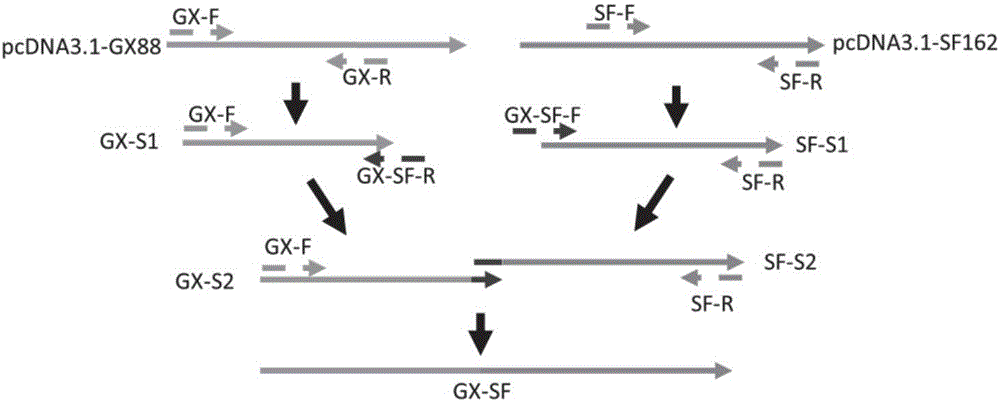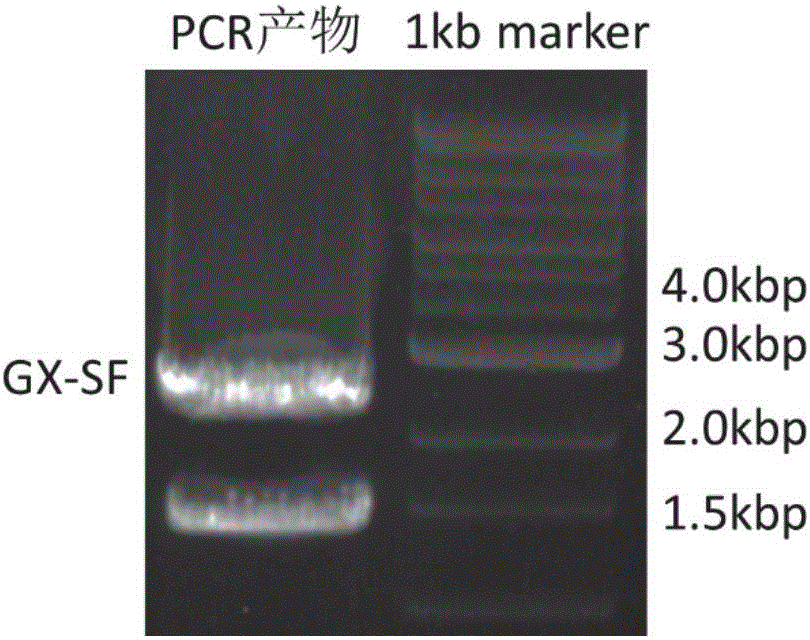Method for detecting ADCC (antibody-dependent cell-mediated cytotoxicity) activity of anti-HIV (human immunodeficiency virus) antibody
A carrier and packaging carrier technology, applied in the fields of molecular virology and genetic engineering, can solve the problem that the detection method is difficult to meet the evaluation of large-scale clinical trial samples
- Summary
- Abstract
- Description
- Claims
- Application Information
AI Technical Summary
Problems solved by technology
Method used
Image
Examples
Embodiment 1
[0084] Construction and identification of embodiment 1.GX-SF expression plasmid
[0085] CX-SF recombinant envelope protein comes from the transformation of pcDNA3.1-SF162 and pcDNA3.1-GX88. pcDNA3.1-SF162 comes from NIH AIDS Reagent in the United States; pcDNA3.1-GX88 comes from the isolates from patient serum in our laboratory. The isolated strain is obtained by extracting HIV RNA from plasma with the Qiagen Viral RNA Extraction Kit, reverse-transcribing it into cDNA, amplifying the membrane region fragment by PCR, connecting the T vector, picking a single clone, sequencing, and finally obtaining a monoclonal isolate The membrane protein GX88. The GX-SF envelope protein transformation process is as follows: figure 1 As shown, the specific steps include:
[0086] 1) Using pcDNA3.1-SF162 as a template, design primers:
[0087] SF-F: 5'-GTGGAGATATGAGGGACAAT-3'
[0088] SF-R: 5'-TTATAGCAAAGCCCCTTTCAAAGCC-3'
[0089] The sequence was amplified by 1386-2544bp to obtain the f...
Embodiment 2
[0100] The preparation of embodiment 2.HIV pseudovirus
[0101] 2.1 HIV pseudovirus packaging system
[0102] Pseudoviruses were prepared by co-transfecting eukaryotic cells with envelope protein expression plasmids and backbone plasmids. Among them, the HIV backbone plasmid used and the specific conditions for co-transfecting eukaryotic cells are described in detail in "Chinese Patent Application CN104830908A", which is incorporated herein by reference in its entirety. In this example, an exemplary envelope protein expression plasmid (pcDNA3.1) and a backbone plasmid (pSG3.Aenv.cmvFluc, referred to as pSG3-Fluc) were used to prepare HIV pseudoviruses.
[0103] 2.2 Expression of envelope protein expression plasmid and backbone plasmid in eukaryotic cells
[0104] 293FT cells were digested with trypsin, counted, and 6×10 6 Cells / 15ml inoculated on 75cm 2 Cell culture flasks, 37 °C, 5% CO 2 cultured in an incubator. When the confluence rate of the cells reaches about 50%, ...
Embodiment 3
[0113] Embodiment 3.GX-SF pseudovirus ADCC detection method
[0114] Use CEM-NKr cells as target cells. After counting the cells, dilute the number of cells to 1E6 / mL, and take 1 mL of cells. According to the calculation results, dilute the virus of the desired strain to MOI=1.0, put it into a T25 culture bottle, and make up the medium volume to 5 mL. Add 5 μL of 15mg / mL DEAE and mix well. Centrifuge at 1200g room temperature for 120min. 5% CO at 37°C 2 Incubate for 2 hours. The prepared target cells were washed 3 times with PBS. Follow 1 x 10 per well 4 cells / 50 μL, the cells were seeded in a U-shaped 96-well plate, and the wells around the plate were left as controls. Control wells were set as follows: Ee wells had only effector cells (NK92-6DF5 cells), Te and Tm had only target cells (CEM-NKr cells), P and V had only 150 μL medium, and empty wells were filled with 150 μL PBS. Dilute NK92-6DF5 cells to 1 x 10 5Cells / 50 μL were seeded in 96-well plates. Gently tap th...
PUM
 Login to View More
Login to View More Abstract
Description
Claims
Application Information
 Login to View More
Login to View More - R&D
- Intellectual Property
- Life Sciences
- Materials
- Tech Scout
- Unparalleled Data Quality
- Higher Quality Content
- 60% Fewer Hallucinations
Browse by: Latest US Patents, China's latest patents, Technical Efficacy Thesaurus, Application Domain, Technology Topic, Popular Technical Reports.
© 2025 PatSnap. All rights reserved.Legal|Privacy policy|Modern Slavery Act Transparency Statement|Sitemap|About US| Contact US: help@patsnap.com



